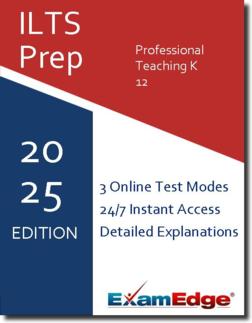ILTS Professional Teaching K-12 (188) Practice Tests & Test Prep by Exam Edge - Topics
Based on 28 Reviews
- Real Exam Simulation: Timed questions and matching content build comfort for your ILTS Professional Teaching K-12 test day.
- Instant, 24/7 Access: Web-based ILTS Assessment of Professional Teaching (APT) K-12 practice exams with no software needed.
- Clear Explanations: Step-by-step answers and explanations for your ILTS exam to strengthen understanding.
- Boosted Confidence: Reduces anxiety and improves test-taking skills to ace your ILTS Assessment of Professional Teaching (APT) K-12 (188).

Understanding the exact breakdown of the ILTS Assessment of Professional Teaching (APT) K-12 test will help you know what to expect and how to most effectively prepare. The ILTS Assessment of Professional Teaching (APT) K-12 has 120 multiple-choice questions and 2 essay questions. The exam will be broken down into the sections below:
| ILTS Assessment of Professional Teaching (APT) K-12 Exam Blueprint | ||
|---|---|---|
| Domain Name | % | Number of Questions |
| Development and Learning | 20% | 24 |
| Learning Environment | 30% | 36 |
| Instruction and Assessment | 35% | 42 |
| Professional Environment | 15% | 18 |
| ** Instruction and Assessment and Learning Environment have CRI questions | ||


